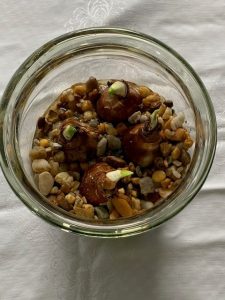Forcing bulbs refers to the practice of inducing bulbs to bloom earlier than they would naturally. The primary benefit is to enjoy the flowers earlier in the year than their natural bloom time. Forcing allows you to have colorful blooms indoors during late winter when outdoor gardens may still be dormant.
 My Granny lived in the mountains of southwest Virginia, and every year she had blooming daffodils in her kitchen. Having flowers indoors, especially during colder months, can have a positive effect on our moods and well-being. They are used for decorative purposes also adding color and fragrance to indoor spaces.
My Granny lived in the mountains of southwest Virginia, and every year she had blooming daffodils in her kitchen. Having flowers indoors, especially during colder months, can have a positive effect on our moods and well-being. They are used for decorative purposes also adding color and fragrance to indoor spaces.
How to force bulbs
The amaryllis, narcissus, and allium are some of the easiest of true bulbs to force. Potting media can be soil, pebbles, or only water. In soil, (use a coarse potting mix) large to medium bark chunks. Fill the container with soil leaving at least 1 inch from the top of the container. Only cover halfway in soil, leaving the top of the bulb visible. Having 3-4 bulbs in a container makes for a nice display. Make sure ¼ to ½ of the bulb is exposed above the soil line. Planting too deep can cause rot. Water in well, allowing water to drain, and keep the container at room temperature and bright light to stimulate root, foliage, and flower growth.
 Pebbles or tiny stones allow you to see roots intertwining around the pebbles, especially in a clear glass container. The pebbles serve as support and offer a nice color contrast with the green stems and colored blooms. Gently push the bulbs into the pebbles just until ¼ to ½ of top of the bulb is left exposed. Add water until it just reaches the base of the bulb. The roots will find the water and start to grow downwards. Always keep the water just below the bottom of the bulbs.
Pebbles or tiny stones allow you to see roots intertwining around the pebbles, especially in a clear glass container. The pebbles serve as support and offer a nice color contrast with the green stems and colored blooms. Gently push the bulbs into the pebbles just until ¼ to ½ of top of the bulb is left exposed. Add water until it just reaches the base of the bulb. The roots will find the water and start to grow downwards. Always keep the water just below the bottom of the bulbs.
In water I think is the neatest way to see the growth process of plants and could be used as hands-on way to teach plant life cycles. Successful forcing requires careful attention to temperature, light, and moisture conditions to mimic the bulb’s natural growth cycle.
 0
0
